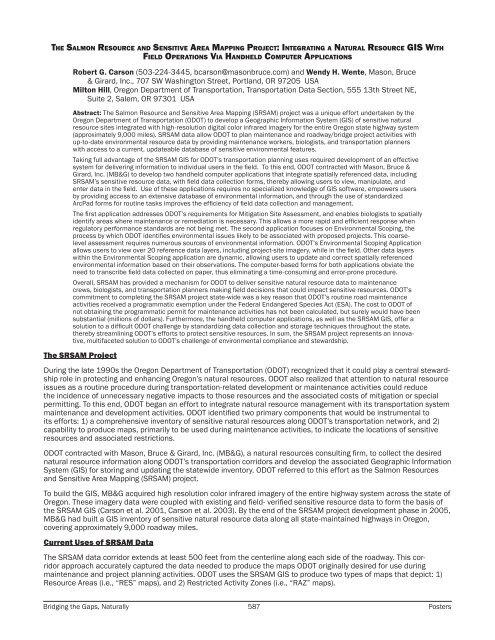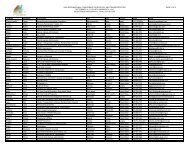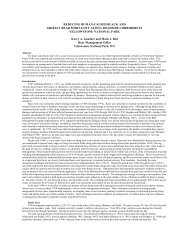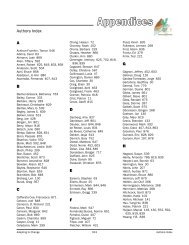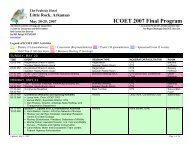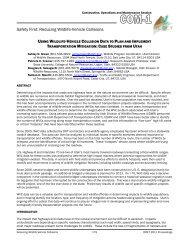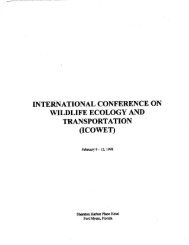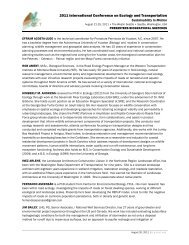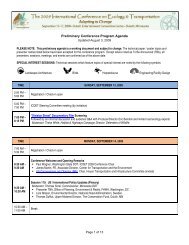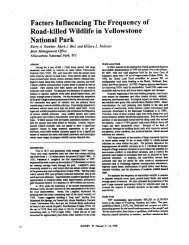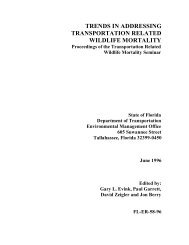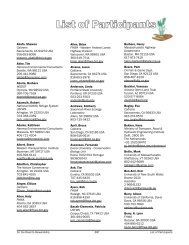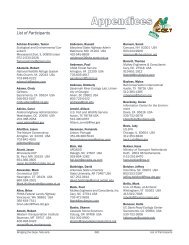Poster Sessions, pages 567-640 - ICOET
Poster Sessions, pages 567-640 - ICOET
Poster Sessions, pages 567-640 - ICOET
You also want an ePaper? Increase the reach of your titles
YUMPU automatically turns print PDFs into web optimized ePapers that Google loves.
The Salmon Resource and Sensitive Area Mapping Project: Integrating a Natural Resource GIS With<br />
Field Operations Via Handheld Computer Applications<br />
Robert G. Carson (503-224-3445, bcarson@masonbruce.com) and Wendy H. Wente, Mason, Bruce<br />
& Girard, Inc., 707 SW Washington Street, Portland, OR 97205 USA<br />
Milton Hill, Oregon Department of Transportation, Transportation Data Section, 555 13th Street NE,<br />
Suite 2, Salem, OR 97301 USA<br />
Abstract: The Salmon Resource and Sensitive Area Mapping (SRSAM) project was a unique effort undertaken by the<br />
Oregon Department of Transportation (ODOT) to develop a Geographic Information System (GIS) of sensitive natural<br />
resource sites integrated with high-resolution digital color infrared imagery for the entire Oregon state highway system<br />
(approximately 9,000 miles). SRSAM data allow ODOT to plan maintenance and roadway/bridge project activities with<br />
up-to-date environmental resource data by providing maintenance workers, biologists, and transportation planners<br />
with access to a current, updateable database of sensitive environmental features.<br />
Taking full advantage of the SRSAM GIS for ODOT’s transportation planning uses required development of an effective<br />
system for delivering information to individual users in the field. To this end, ODOT contracted with Mason, Bruce &<br />
Girard, Inc. (MB&G) to develop two handheld computer applications that integrate spatially referenced data, including<br />
SRSAM’s sensitive resource data, with field data collection forms, thereby allowing users to view, manipulate, and<br />
enter data in the field. Use of these applications requires no specialized knowledge of GIS software, empowers users<br />
by providing access to an extensive database of environmental information, and through the use of standardized<br />
ArcPad forms for routine tasks improves the efficiency of field data collection and management.<br />
The first application addresses ODOT’s requirements for Mitigation Site Assessment, and enables biologists to spatially<br />
identify areas where maintenance or remediation is necessary. This allows a more rapid and efficient response when<br />
regulatory performance standards are not being met. The second application focuses on Environmental Scoping, the<br />
process by which ODOT identifies environmental issues likely to be associated with proposed projects. This coarselevel<br />
assessment requires numerous sources of environmental information. ODOT’s Environmental Scoping Application<br />
allows users to view over 20 reference data layers, including project-site imagery, while in the field. Other data layers<br />
within the Environmental Scoping application are dynamic, allowing users to update and correct spatially referenced<br />
environmental information based on their observations. The computer-based forms for both applications obviate the<br />
need to transcribe field data collected on paper, thus eliminating a time-consuming and error-prone procedure.<br />
Overall, SRSAM has provided a mechanism for ODOT to deliver sensitive natural resource data to maintenance<br />
crews, biologists, and transportation planners making field decisions that could impact sensitive resources. ODOT’s<br />
commitment to completing the SRSAM project state-wide was a key reason that ODOT’s routine road maintenance<br />
activities received a programmatic exemption under the Federal Endangered Species Act (ESA). The cost to ODOT of<br />
not obtaining the programmatic permit for maintenance activities has not been calculated, but surely would have been<br />
substantial (millions of dollars). Furthermore, the handheld computer applications, as well as the SRSAM GIS, offer a<br />
solution to a difficult ODOT challenge by standardizing data collection and storage techniques throughout the state,<br />
thereby streamlining ODOT’s efforts to protect sensitive resources. In sum, the SRSAM project represents an innovative,<br />
multifaceted solution to ODOT’s challenge of environmental compliance and stewardship.<br />
The SRSAM Project<br />
During the late 1990s the Oregon Department of Transportation (ODOT) recognized that it could play a central stewardship<br />
role in protecting and enhancing Oregon’s natural resources. ODOT also realized that attention to natural resource<br />
issues as a routine procedure during transportation-related development or maintenance activities could reduce<br />
the incidence of unnecessary negative impacts to those resources and the associated costs of mitigation or special<br />
permitting. To this end, ODOT began an effort to integrate natural resource management with its transportation system<br />
maintenance and development activities. ODOT identified two primary components that would be instrumental to<br />
its efforts: 1) a comprehensive inventory of sensitive natural resources along ODOT’s transportation network, and 2)<br />
capability to produce maps, primarily to be used during maintenance activities, to indicate the locations of sensitive<br />
resources and associated restrictions.<br />
ODOT contracted with Mason, Bruce & Girard, Inc. (MB&G), a natural resources consulting firm, to collect the desired<br />
natural resource information along ODOT’s transportation corridors and develop the associated Geographic Information<br />
System (GIS) for storing and updating the statewide inventory. ODOT referred to this effort as the Salmon Resources<br />
and Sensitive Area Mapping (SRSAM) project.<br />
To build the GIS, MB&G acquired high resolution color infrared imagery of the entire highway system across the state of<br />
Oregon. These imagery data were coupled with existing and field- verified sensitive resource data to form the basis of<br />
the SRSAM GIS (Carson et al. 2001, Carson et al. 2003). By the end of the SRSAM project development phase in 2005,<br />
MB&G had built a GIS inventory of sensitive natural resource data along all state-maintained highways in Oregon,<br />
covering approximately 9,000 roadway miles.<br />
Current Uses of SRSAM Data<br />
The SRSAM data corridor extends at least 500 feet from the centerline along each side of the roadway. This corridor<br />
approach accurately captured the data needed to produce the maps ODOT originally desired for use during<br />
maintenance and project planning activities. ODOT uses the SRSAM GIS to produce two types of maps that depict: 1)<br />
Resource Areas (i.e., “RES” maps), and 2) Restricted Activity Zones (i.e., “RAZ” maps).<br />
Bridging the Gaps, Naturally 587 <strong>Poster</strong>s


